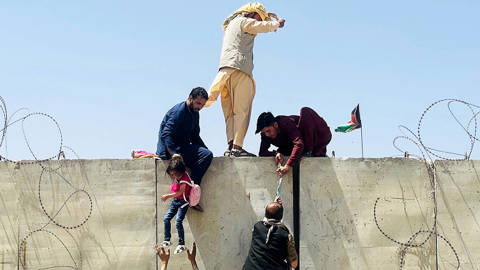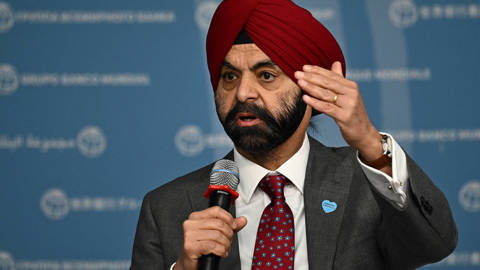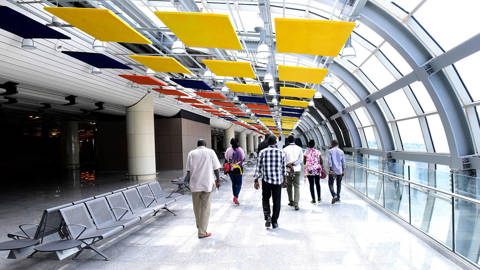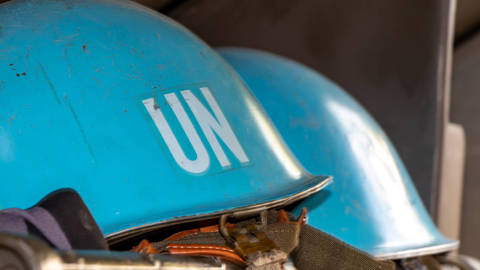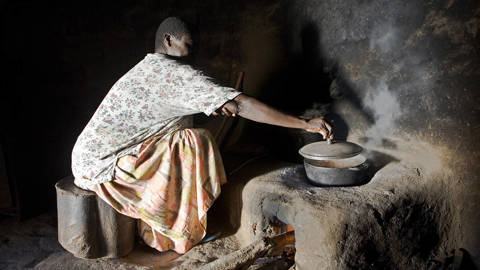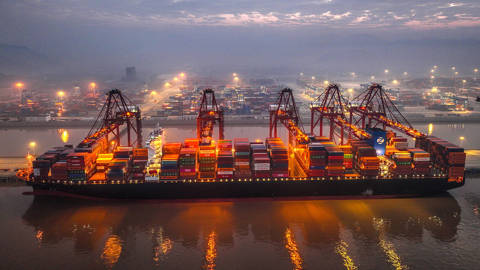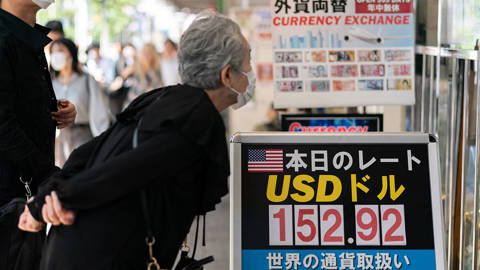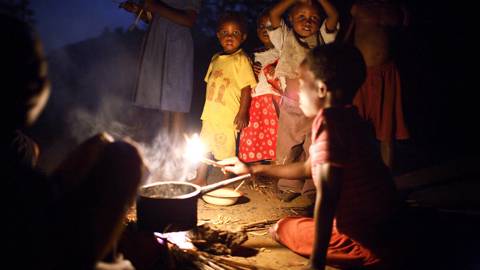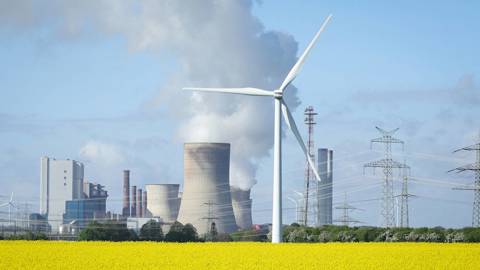America’s Afghan Debacle
The Taliban has announced its interim government, and its all-male, often-hardline makeup seems to have confirmed many observers’ worst fears. Why did the US mission in Afghanistan fail, and what is in store for the country under Taliban rule?
Listen and subscribe to all episodes from your favorite podcast app. Find Opinion Has It on Apple Podcasts, Google Podcasts, Acast, or via RSS Feed. Have a suggestion for an episode? Email us at podcasts@project-syndicate.org.
Transcript
Elmira Bayrasli: Welcome to Opinion Has It. I’m Elmira Bayrasli.
An Islamic Emirate. That’s how Afghanistan’s Taliban leaders have described the country they now rule. And despite earlier promises of diverse representation, they’ve created an all-male interim government, packed with hardliners.
Archive Recording: The new Taliban showed its true colors, and you know what? They’re exactly the same colors as the old Taliban.
Archive Recording: I think the only people that are going to be surprised are those that believed the Taliban when they spoke about an all-encompassing government that would include women.
Archive Recording: It’s an all-male cabinet dominated by hardliners and includes an interior minister who is on the FBI’s Most Wanted list, with a $5 million bounty on his head.
EB: Meanwhile, fears that Afghanistan is set to become a hotbed for terrorist activity are growing.
Archive Recording: We begin in Afghanistan, where an explosion struck a Shia mosque during Friday prayers. It happened in the southern province of Kandahar. At least 15 people are reported dead so far, and scores are injured.
Archive Recording: The US military believes there are what they describe as 2,000 hardcore Islamic State fighters on the ground.
Archive Recording: Just a week ago, dozens were killed in a suicide bombing at a Shia mosque in the country’s north.
Archive Recording: The other key threat is from al-Qaeda. Unlike ISIS, al-Qaeda has close ties to the Taliban. A former special forces officer says the West’s defeat in Afghanistan means there’s a greater chance of foreign fighters signing up.
EB: None of this looks good for the United States, which spent 20 years and $2 trillion trying to prevent precisely this outcome.
Archive Recording, General Mark Milley: I think that our credibility with allies and partners around the world and with adversaries is being intensely reviewed by them to see which way this is going to go.
EB: Why did the US mission in Afghanistan fail? Was a rapid withdrawal really America’s only option? What will happen to Afghanistan now?
Hi Annie.
Annie Pforzheimer: Hi.
EB: Here to help us answer these questions is Annie Pforzheimer.
AP: You asked for the voice memo recording.
EB: Annie is a non-resident associate at the Center for Strategic and International Studies.
AP: I have it, and I’m pretty sure it works, and I’m pretty sure I know how to send it.
EB: She was formerly the acting deputy assistant secretary of state for Afghanistan and a deputy chief of mission in Kabul. She joins us from New York and, in classic New York style, some construction work started up during the last few minutes of our conversation. I hope you’ll bear with us.
Annie, I want to start by focusing on the social progress that the US-led invasion and occupation brought to Afghanistan. How did Afghan society change for the better in recent years?
AP: I think that Afghan society changed definitely for the better with a couple of indicators in respect to health and education, and the sort of social indicators of access to things like water and electricity. These were undeniable. There are lots of good metrics. You know, I particularly think it’s important that maternal mortality went down by two-thirds. It just became a better country to be a woman. And that wasn’t to say, you know, we’re talking about the high-end indicators of how many people got graduate degrees and how many women were in the robotics clubs. This is a real sort of on-the-ground ability of women to survive having children, because they are going to give birth with actual trained staff, or the ability of girls to go to school, which everyone knows – and the numbers show – leads to usually a decline in birth rate and an increase in the life expectancy for women.
EB: So are any of these improvements, like the ones you just mentioned about women’s health, likely to stick now that the Taliban are back in charge?
AP: I am afraid, I think a lot of the health indicators in particular, and obviously all the ones relating to education – they are about to suffer a real decline. What you need is trained staff, and you need trained staff of both genders. And at first pass, the Taliban were even saying that maybe women doctors couldn’t show up to work. They’ve walked some of that back, but you do need the funding and the sort of overall ability of women, for example, to get to the hospital. Even if the hospital’s funded and the staff is there, the Taliban imposed a very strict prohibition against women going anywhere. Their freedom of movement is constrained if they don’t have the proper male relative with them. Well, if you’re giving birth, and you are suffering some kind of trauma, and your male relative isn’t there, they would rather that you die in your home, rather than reach help. So I think that all the indicators that we know about, they are impacted negatively by the Taliban restricting movement and restricting women’s access to work.
EB: Still, the majority of Afghanistan’s budget in recent years has come from foreign aid, and many donors are hoping they can use conditions to essentially force the Taliban to respect women’s rights. Can this actually work?
AP: But this is – I think the first premise is the one that we have to look at and possibly question: Do they want the foreign aid? I’m not completely certain that they do. The people suffering are not necessarily people that they are bound to. And if they feel that the foreign aid brings with it restrictions and conditions that somehow undermine the ideological purity of their rule, I think they’re making a series of decisions right this minute that indicate that they would rather live without it.
And furthermore, they have bet over the last couple of years on the West feeling more compunction than they do and trying to be more helpful than they are. So, they’ve had some conversations with the US, the EU, and others about aid conditionality, in which they’re making a set of fairly flimsy commitments, and they’re not showing it in their actions. And they’re waiting to see if we will unbend first.
EB: While Western leaders are hoping to protect women’s rights today, social progress was never the point of the war in Afghanistan. Instead, the US and its allies wanted to capture Osama bin Laden, rout out al-Qaeda terrorists, and oust the Taliban regime that had given them sanctuary.
Archive Recording, President George W. Bush: On my orders, the United States military has begun strikes against al-Qaeda terrorist-training camps, and military installations of the Taliban regime in Afghanistan. These carefully targeted actions are designed to disrupt the use of Afghanistan as a terrorist base of operations, and to attack the military capability of the Taliban regime.
EB: The US then sought to ensure that Afghanistan wouldn’t again become a safe haven for terrorist groups. It invested hundreds of billions in the Afghan army and police forces so that eventually they would be able to take responsibility for the country’s security.
Archive Recording, General William Caldwell: I can tell you this: there has been significant progress made in the development of the Afghan National Security Force over the past 20 months. What you do see – you see a tremendous growing pride in themselves and in who they are. There’s a much greater sense of nationalism being exhibited, especially through the army forces, than there was 20 months ago.
EB: But when the US withdrew its military and intelligence resources this year, Afghan security forces were no match for the Taliban.
Archive Recording: The Taliban are advancing relentlessly across Afghanistan as the US carries out the final stages of withdrawing all its troops.
Archive Recording: The militants are adding to their ranks, freeing Taliban prisoners in several cities.
Archive Recording: As ever, it’s the civilians who are paying the highest price. More than a thousand have been killed in recent weeks, and many, many more have been pushed from their homes as they’re caught up in the fighting.
EB: It took the Taliban less than two weeks to seize control of virtually all of Afghanistan. Cities and districts often fell without Afghan security forces firing a single shot.
Archive Recording: Afghanistan’s president, Ashraf Ghani, has gone. He’s left the country as Taliban leaders push for what they say is a peaceful transfer of power in Kabul.
EB: Soon, Taliban leaders were celebrating their victory in the presidential palace in Kabul. Annie says this reflected a fundamental flaw in US strategy.
AP: The US military made a bet on a certain type of training and design model for the Afghan military. And that bet was a highly centralized military, which as it turns out, they designed to be utterly dependent on the United States in three key areas: our air support, our logistics support, and our intelligence support. You know, yes, there was a military. There were a number of Afghan men wearing uniforms. There was a growing cadre of younger people who were becoming very, very skilled officers. But the weaknesses still existed in those three areas – you know, air support, logistics, and intelligence. And with the decision of the Biden administration to withdraw all support in those three areas and beyond, with a date certain, I don’t think it was possible for the Afghan military to recover either psychologically or just operationally and suddenly achieve a level of advanced integration that they hadn’t during the time we were there. I don’t think the US made grave errors with respect to the idea of an integrated Afghan military. But the big errors were in our self-assessment of its readiness. And then somewhere there was a very big error in what the military and the political leadership of this administration and maybe the previous one decided constituted readiness to take over without the support that they had had all along.
EB: Annie, when I take a look at the Biden administration, it doesn’t seem they paid much attention to these failures, at least not publicly. And instead, they claim that the Taliban’s quick takeover was proof that no amount of training would have been enough. In fact, Biden himself says that he had only two options when it came to Afghanistan: to leave completely or deploy more American troops. But you say, this is a false dichotomy. What should he have done?
AP: Yeah, I think that that dichotomy that he presented to the American people, it’s very self-serving, and it followed a somewhat long tradition of us oversimplifying the choices when discussing with the American people or Congress.
There are always more than two choices, of course. But in this particular case, Congress had set forward an Afghanistan study group that took all of 2020 to try to handle the question that was going to be posed to the president. In other words, what should he do with the agreement that President Trump had made in February of 2020 and the circumstances on the ground, the readiness or lack thereof of the Afghan security forces, the threats posed by the Taliban and ISIS? It was a study group comprised of nonpartisan experts from the military, think tanks, former members of Congress. And they came up with a proposed way forward that they presented through the US Institute of Peace in February of 2021.
And so this was what President Biden actually was given. Rather than having to conduct a whole separate strategy review, one was made for him. And that proposal was neither of the two that he said he was faced with. It was to keep about 4,500 troops on the ground, to double down on negotiations, to change the game with the Taliban to impose more of the conditionality that they had to break their ties with al-Qaeda, and to basically use the leverage that we had to try to advance the negotiations.
Instead, the president made his choice in April, and that was, not coincidentally, the time that the Taliban broke off negotiations. So I think the emphasis of this study group was, what’s the minimal amount of US force that needs to be on the ground in order to make negotiations – a negotiated solution – a viable prospect? And was it a perfect option? You know, nothing is perfect. But looking at what we are dealing with right now, I think this was an excellent choice that the president could have taken that wouldn’t have ended up with whole-scale war. The Americans were not on the front lines. And it would have guaranteed us a better chance at a negotiated solution.
EB: But wouldn’t that have been violated the deal that the Trump administration had made with the Taliban?
AP: I think that the February 2020 agreement that President Trump signed – it actually had conditionality to it, which meant that the deadline that was in the agreement of May 2021, that deadline depended on both sides keeping to their conditions. So we weren’t actually obligated to withdraw by 2021, because the Taliban hadn’t kept up their side of the deal. That’s number one. But number two, I really don’t see that this president has felt himself extremely bound to other decisions of the previous administration. I think he has exhibited the ability to reverse Trump administration decisions. And so it feels false to me to hear that they had nothing that they could do because the previous administration had made a commitment.
EB: Whatever alternative paths Biden could have taken, one thing was clear: the United States wasn’t prepared for the Taliban to take over so quickly.
Archive Recording: There’ve been further chaotic scenes outside the international airport in Kabul as thousands of Afghans try to flee the country following its fall to the Taliban.
Archive Recording: Extraordinary and harrowing footage emerged of people desperately trying to get onto planes.
Archive Recording: Helicopters and airplanes circled over Kabul, shuttling between the embassy, where sensitive documents were burned, and the airport, as the Taliban closed in.
Archive Recording: This disorderly end was not the plan.
EB: To say the evacuation was chaotic and rushed is an understatement. In a matter of 17 days, US and coalition aircraft evacuated over 120,000 Americans, foreign citizens, and Afghan allies. It was one of the largest airlifts in history. Yet it wasn’t enough.
Annie, the Biden administration hasn’t been criticized only for its decision to withdraw, but also for how the withdrawal unfolded. When official efforts to evacuate allies fell short, aid organizations, veterans, and volunteers stepped in to help out. What did these civilian efforts look like? And do you think this further undermined the American government’s credibility abroad?
AP: I don’t know about our credibility. I will say that overall NATO countries, you know, expressed their concern and even discussed how we had essentially obligated them to withdraw in the same way. And many of them are still working to evacuate their allies, particularly Great Britain. But I do know that the evacuation efforts by civilians, particularly, you know, veterans, people who’ve worked with NGOs – I am on the board of an organization which has hundreds of vulnerable people left behind – these efforts are ongoing, and they are piecemeal, but it’s the most extraordinary sort of coalition of people trying to help each other wade through the bureaucratic mess that is the current refugee system, through the real dangers that people face.
You know, somebody worked for a women’s shelter that the US government was funding. Well, the Taliban came through and let everybody out of the jails, and that includes people who had abused women, who had done really unspeakable things to young girls. Well, they’re now out of jail. And so one of the first things they’re looking for is the case worker and social worker and lawyers who actually were part of the justice system and put them there.
So people need to get out. But even more than that, the US has to think about all the people who will never be evacuated, who can’t be. That’s millions of people. So what are we doing to help safeguard the most basic human rights? The right of non-retribution that the Taliban is allegedly going around and killing people who work for the security forces, the right of movement, the right of girls to schooling, the right of health care. What are we doing as a country for all of those that we can’t evacuate?
EB: The Taliban are far from invincible. Many government officials are wildly unqualified for their roles. And there are rumors of infighting between Taliban moderates and hardliners.
Archive Recording: Over in Afghanistan, there are reports of factional infighting continuing in that country.
Archive Recording: A bit of a row has broken up there between leaders of the Taliban over the make-up of the group’s new government. Senior Taliban officials have told the BBC the row involved a strong exchange of words at the presidential palace over who should take credit for the group’s victory.
EB: Meanwhile, Afghanistan is on the brink of economic collapse.
Archive Recording: On the streets of Kabul, countless vendors are out to sell, but no one is buying.
Archive Recording: Today we’re seeing prices of everyday goods like lentils, vegetable oil, flour skyrocket in price.
Archive Recording: There is no cash coming into Afghanistan.
Archive Recording: Shuttered banks, lack of enough food, and continued instability all plague the nation.
EB: All of this raises serious questions about the Taliban’s ability to govern.
AP: They can certainly rule through brutality. They have shown their ability to carry out swift punishment. They can shoot demonstrators, which they’ve done. They can keep control, in other words. But can they govern? They don’t have a cadre of technocrats, and the ones in Afghanistan, you know, some are back at their jobs, but obviously women are not. Some are terrified and are trying to leave the country. There is a real brain drain. So, who is going to manage the water system, the electricity system? Who is going to administer taxes and customs? I think the Taliban is extremely vulnerable if they continue in this way, because they will have what was a modern or becoming a real modern economy, they will be sort of disrupting it, thinking, “Okay, if we rule rural people, that’s easier.” But they can’t rewind the clock. Afghanistan has become urbanized and it has become a country with a real infrastructure. Once they break it, I don’t know how they think they’re going to repair it.
EB: It’s not just the economy the Taliban have to worry about though. We’re hearing a lot about the Islamic State – Khorason, ISIS-K. That’s the official ISIS affiliate operating in Afghanistan. How big a threat does ISIS-K pose to the new government?
AP: I think they could – I mean, obviously they’re getting challenged to some degree by ISIS, although there are plenty of conflicting explanations of what’s really going on there. ISIS has carried out a series of attacks against the Shia minority population. They have also carried out attacks against Taliban officials. So they probably pose one of the most serious security threats.
EB: Even if the Taliban government gets ISIS-K under control, the risk of Afghanistan becoming a terrorist haven won’t be eliminated. The Taliban could still decide to give sanctuary to the terrorist groups to which it is linked. In fact, the new interior minister is the leader of the Haqqani network, a militant group that maintains ties to al-Qaeda.
Archive Recording: Sirajuddin Haqqani, Afghanistan’s new interior minister, is wanted for questioning by the FBI.
Archive Recording: Now he’s been linked to some of the most violent terror attacks there. The FBI has issued a $10 million reward for information leading to his capture.
Archive Recording: The Haqqani network has been blamed for various attacks in Afghanistan. It was also blamed for at least one of the reported six assassination attempts of the former president of Afghanistan, Hamid Karzai.
EB: Harboring terrorists is what got the Taliban ousted 20 years ago. The question now is whether that memory will be enough to motivate the Taliban to keep terrorist activity in check.
Annie, the Taliban still have ties to terrorist groups, including al-Qaeda. How likely is the Taliban to provide sanctuary to them as it has in the past?
AP: I don’t think that they have any real problem with doing so. I would assume that they will require those terrorist groups to behave in a certain fashion and not to challenge them in any way. But I don’t really think that they have a lot of rationale to reject them because at this moment, their view of the international community, the one that people sort of wishfully thought they wanted to join, is that they are stronger and better than the international community – I mean, within the boundaries of Afghanistan. They believe that the purity of their ideology is why they got where they are today. And so I don’t think that they could find any reason why they had to make compromises. I mean, the money issue is the big question mark. Could we, the international community, buy our way into a more compliant Taliban? I would guess, unfortunately, that over time, yes, but so many people will suffer between now and that point.
EB: And what unfolds in Afghanistan will depend partly on its neighbors. How are regional powers like Pakistan and Iran looking at the void left by the United States, and what pressures might that place on the Taliban?
AP: Well, in the case of Iran, they haven’t made a lot of overt gestures. But if the Shia population continues to be the main target, and the Taliban is unable or unwilling to put a stop to it, precedent might show that a country in that position would say, “Well, if you can’t protect our co-religionists, then we’re going to have to.” That would be a big expenditure of energy for Iran if they really wanted to do something in Afghanistan militarily. But they might also decide to start arming that population.
With respect to Pakistan – of course, you know, I think I’m one of the camp of people who believe that Pakistan was absolutely the fundamental backer for the Taliban. It wasn’t always about the money; sometimes it was about the intelligence or the military advice-giving. At the end, when the Afghan military lost its international backer, the Taliban still had theirs, and that made a big difference.
But I think Pakistan and the Taliban don’t quite know what to do with each other right this minute. The Pakistanis have shown up in Kabul, you know, senior military and intelligence officials, sort of openly in their role as senior advisers. But they have troubles at home. They have their own brand of the Taliban, which is very empowered by what just happened. And there are ways in which the Pakistani government feels itself a little bit vulnerable to the Taliban’s appeal. So it’s not been an easy or linear relationship all along. And right now, I think the Taliban feel that they don’t have to listen to very much that the Pakistanis are telling them.
And then, in all of this, you have energy. Afghanistan was poised – I mean, it was something we all really hoped would come online and help its economic future – to be a crossroads of Central Asia energy resources reaching down to Pakistan and even down to India and to Iran. And so these pipelines are almost all, you know, functioning. But Afghanistan doesn’t have energy of its own, and it owes, I think, about $70 million to the Central Asian states, particularly Uzbekistan, to keep the lights on. So, when you talk about vulnerabilities, I mean, I feel like it’s coming from many different directions.
EB: Given Afghanistan’s history and all this potential for instability, one has to wonder: How long will it be before the US is back? In 2011, the US withdrew its troops from Iraq.
Archive Recording, President Barack Obama: I can report that, as promised, the rest of our troops in Iraq will come home by the end of the year. After nearly nine years, America’s war in Iraq will be over.
EB: But less than three years later, American troops were back in Iraq facing down ISIS.
Archive Recording, President Barack Obama: Good evening. Today, I authorized two operations in Iraq: targeted airstrikes to protect our American personnel and a humanitarian effort to help save thousands of Iraqi civilians who are trapped on a mountain without food and water and facing almost certain death.
EB: To this day, the US has boots on the ground in Iraq.
Annie, I want to end by looking at what all this means for America’s involvement in Afghanistan. A decade ago, the United States troop withdrawal from Iraq opened the door for the rise of the Islamic State. And we soon saw the United States again deploying troops to the country. Could something similar force the US to return to Afghanistan?
AP: I don’t see the United States under almost any circumstance putting troops back on the ground in Afghanistan. But the issues there are very serious, and we must remain engaged. The humanitarian needs are so acute that there may be a real outflow of refugees, which in turn will destabilize that region and maybe even Europe. And I think we have both a moral obligation and a strategic interest to make sure that this country remains stable.
EB: Annie, thank you.
AP: Thank you for having me.
EB: That was Annie force Heimer, a non-resident associate with the center for strategic and international studies. And that’s it for this episode. Thanks for listening. We’d love to hear what you think. Please rate and review our podcast. Better yet, subscribe on your favorite listening app. You can also follow us on Twitter by searching for @prosyn. That’s P-R-O-S-Y-N. Until next time, I’m Elmira Bayrasli.
Opinion Has It is produced and edited by Kasia Broussalian. Special thanks to Project Syndicate editors Whitney Arana and Jonathan Stein.
